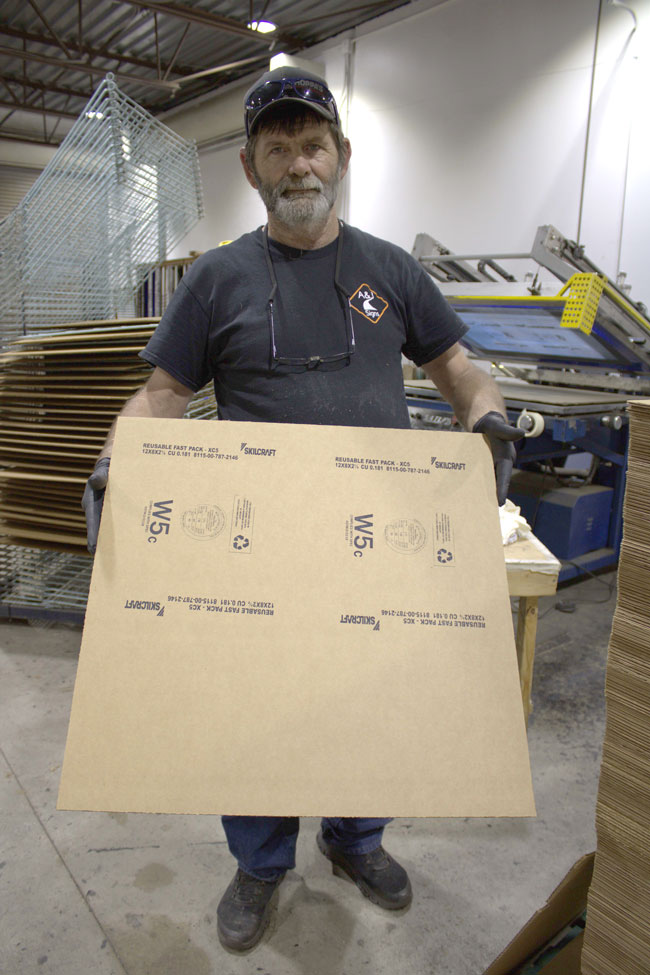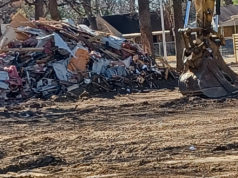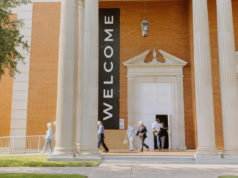“When Independence Begins” is not just any mural. Painted on the exterior of the Lighthouse for the Blind on the Near Southside, it’s interactive. The visually challenged enjoy it by reading inspirational quotes in Braille along the protective outer railing, and large swaths of bright colors make for easier viewing. The 2,000-square-foot artwork by Fort Worth’s Kristen Soble also includes QR codes for more about the institution’s history and mission. And its mission — to provide gainful employment for the visually impaired — has not changed since its inception.
I first heard about this organization many years ago when my beloved, recently departed, legally blind aunt was employed at the San Antonio facility. Being able to work allowed her to live independently and feel respected and purposeful. I never forgot how empowering that was for her and how encouraging that was to see in action. The Lighthouse for the Blind truly focused on releasing limitations and blasted open opportunities and mindsets. I recently decided to take a tour of the facility to learn more about its mission and facilities.
Each Lighthouse for the Blind location follows a similar model but is completely independent and has a unique origin story, including Fort Worth’s. In 1935, the Texas Commission for the Blind chose Willie May Lewis to create an environment where the visually impaired could thrive. With the grace and kindness of the community, she managed to gain support for the organization in the middle of the Great Depression, when most people did not have enough to sustain themselves, much less give to others. Community members sought support door to door, making personal connections that cultivated roots. Since then, the site has undergone changes in leadership and has experienced growth and transformations, giving more visually impaired workers the skills to be able to earn a living wage.
“Opportunity is a word that I use often when talking about the Lighthouse,” said President and CEO Platt L. Allen III. “For us, an opportunity is around every corner, opportunity for competitive employment, opportunity to expand independence.”
Ninety years later, behind the brightly painted wall at 309 S. Adams St., the magic really happens. Through the door at the beginning of the mural, visitors can learn what happens at the 80,000-square-foot manufacturing facility. That’s right. Manufacturing.
*****

Photo By Kena Sosa
School groups and other visitors regularly tour the facility. Fort Worth’s employs the visually challenged to manufacture a wealth of products, from copy paper to flashlights and privacy shields, and from drug-test kits to targets for shooting. The employees work with standard manufacturing machinery adapted for the blind but not changed in purpose. Private and government buyers have publicly praised the quality of Lighthouse’s products. With at least 75% of the 58 employees blind or with low vision, Lighthouse for the Blind is the preferred vendor for many governmental companies, including the military.
“We’ve been working with [Fort Worth’s Lighthouse] for over 20 years,” said Steve Wyatt of Elbit Systems of America, which makes technology-based systems for defense, homeland security, and commercial uses. “Customer service is great. Anytime I need boxes, we have them within a day. Very grateful for everything [they] do.”
Hot Damn, Tamales! is another happy corporate customer.
“We’re grateful to work with Lighthouse for the Blind,” said co-owners Constantine Stavron and mom Ione Stavron in a joint statement. “Their team brings heart, dedication, and a sense of purpose to everything they do. It’s inspiring to be part of something that supports meaningful employment and strengthens our community.”
At a training room on-site, Texas Operations instruments adapt technology for use for all. Magnifiers, Braille keyboards, and audio devices are just a few of the adaptations. For those with low vision or blindness, these skills can open doors to success and independence.
Garry Coufal, head of industrial operations, has worked at this site since 2014, most of the time making shipping/transportation tubes. One branch of Lighthouse’s operations that’s really impressive, Coufal says, is devoted to energy-dissipating pads. They prevent hard impacts for the materials and boxing used by the military and in overseas operations.
Fort Worth’s Lighthouse also creates custom products and services for businesses. It starts with a conversation between Coufal and the prospective business. He asks them what they don’t want to do, then takes that information and creates a model to adapt the task to the blind workers, who get the job done. Last year’s numbers show an impressive level of productivity and efficiency. Fort Worth’s Lighthouse produced 166,027 boxes, which amounts to almost 800 per day and resulted in $4,588,272 in sales.
Interestingly, none of the Lighthouse for the Blind locations make the same products, not because they can’t but because they have no wish to compete with one another. This is an intentional tactic to be successful locally and support one another’s own independent missions. That display of selflessness is rare in business. However, it is a welcome message and reminder that people should be more important than profit.
Industrial Operation Supervisor Jose Barbera said most of the new employees require less training than you might expect. Depending on their role, some need only about a day. The machinery is standard manufacturing quality but has been adapted to be used by the workers who commute to and from work daily.
Optical Lab Manager Brian Talkington runs a highly technical eyewear lab on-site that makes 500 kinds of glasses. Equipped with top-notch machines, the lab’s work is known for its accuracy and precision. The high-tech Easy Fit Trend machine, named Denny, allows the lab to process more than 100 orders per day. Denny was named after Robert D. Alexander, who has been a caring sponsor for the Lighthouse’s mission for years. Talkington pointed out a poster for a program called Mission Optical, a nonprofit that donates glasses to qualifying applicants of all ages. Many similar charities focus on children but drop support for those who need it in adulthood. Mission Optical wants all to be able to see clearly regardless of their stage in life and financial status.
*****
My tour was ending around clock-out time for the workers, but several were willing to stay and show off some of their work. A production line worker, Bobby Worrell, proudly demonstrated the use of the screen-printing machine used to print labels onto boxes. Richard Simpson, another production line worker, displayed a multi-slotted shipping box, one of the many specialized products built here.
Community Outreach Specialist Latrisha Johnson is happy to give tours for school groups and other visitors. Johnson encouraged anyone who enjoys this message to come volunteer and bring in new ideas on serving the community and make connections. It is her mission to see support and the number of people served grow. “Working for [Lighthouse] is amazing because I am helping the same community that helped me.”
The main building is undergoing renovations and should reopen in 2026. The updated facilities will be bigger and have more space for specialty departments like the Optical Lab. In addition, the improved building will feature a fully functioning apartment for trainers to conduct life skills classes like cooking and making the bed for those with visual challenges. Jay Semple, head of client services, is especially excited about this development. “Learning these life skills in a realistic and safe setting will help clients live safely that will boost the ability of clients to live safely and comfortably on their own, which is the goal for many.”
If you or someone you care about is experiencing low vision or blindness, make sure to refer them to the Lighthouse for an empathetic ear, technology advances, and skills for work to enable them to flourish. Best of all, they will gain a community who understands and supports them through life. Sign up for Blind Awareness Training (BAT), which dives deep into communication and exercises that demonstrate the blind and low-sighted experience.
For those whose interests range from art to community-building to how things are made, make your way over to admire the mural on S. Adams Street, even if it is just for the interactive experience. At a time when most things feel complicated and conflicting, go ahead and open the door to a new way of envisioning the world, a place where profit does not outrank the people who make things possible.
In the short time since my visit, my Aunt Carol, who lived her best life during her years at work and in the community of Lighthouse for the Blind in our hometown, passed away peacefully. She was 58. I’m grateful to this organization for empowering her to live up to her own expectations on what her life could be. And in her memory, I hope to share encouragement for what is possible when we refuse to accept others’ expectations and live the life we want. Spreading the word about this organization feels like the best way to do that.












